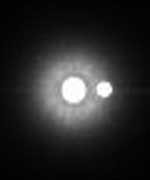The Canadian da Vinci Project Team has notified the ANSARI X PRIZE of its intention to launch its rocket on October 2nd, 2004, marking its official entry in the international, commercially-funded space race competition.
The da Vinci Project, which unveiled its rocket Wild Fire today, joins one American team — in a field of 26 — to announce its launch date. “With two ANSARI X PRIZE teams launching within days of each other for the $10 million prize (U.S.), we truly have a remarkable race for space,” said Dr. Peter H. Diamandis, Chairman and Founder of the X PRIZE Foundation. The recipient of the $10 million prize will be the first team to travel safely to space twice within a two-week period on a privately funded, re-useable spacecraft.
Brian Feeney, who plans to pilot Wild Fire approximately 85 kilometers into suborbital space, said the team is finalizing construction of the rocket as well as logistical details related to the event, which will be held in Kindersley, Saskatchewan.
“We’re very close to achieving our mission, thanks to the organizations and individuals that understand the significance of this race,” said Feeney. “The da Vinci Project is on the cusp of a new era of space travel for humankind. Our team is proof positive that ingenuity and innovation can overcome the impossible.”
In addition, Feeney announced a new sponsor to finance the project. Golden Palace.Com, the world’s largest online casino, has signed on as the title sponsor. The Golden Palace.Com Space Program — Powered By The da Vinci Project — is poised to make history.
According to sources at the casino, GoldenPalace.com is excited and very proud to be a part of the historic flight of the Wild Fire. In the continuing pursuit for innovative ideas for exposure, Golden Palace sources believes the ANSARI X Prize competition provides the advertising exposure as well as the added incentive of a history-making event that will eventually serve to benefit all humankind.
The da Vinci Project, which Feeney describes as the largest volunteer technology project in Canada, has achieved several critical milestones since officially entering the competition in 1996. These milestones have included the filing of necessary papers to Canadian government for launch approval; securing the site for launch; the testing of engine components; testing the design and securing a wide range of sponsors including Sun Microsystems of Canada, Blake Cassels Graydon, ANSYS, Hinz Automation and Kindersley Transport.
“The da Vinci Project is emblematic of the spirit of the ANSARI X PRIZE,” said Diamandis. “It brings together many of the best and brightest to break down preconceived notions on space travel and prove that we are no longer bound to one planet.”
The X PRIZE Foundation is working with the Federation Aeronautique Internationale (FAI), the international body responsible for all aviation and space world records, to ensure that the ANSARI X PRIZE winner will also receive official international recognition for his achievement. In addition to duration, altitude and distance, the FAI has introduced new world record categories for ‘minimum time between two consecutive sub-orbital flights in a reusable vehicle’ and ‘number of persons carried in sub-orbital flight’.
Original Source: da Vinci Project News Release

